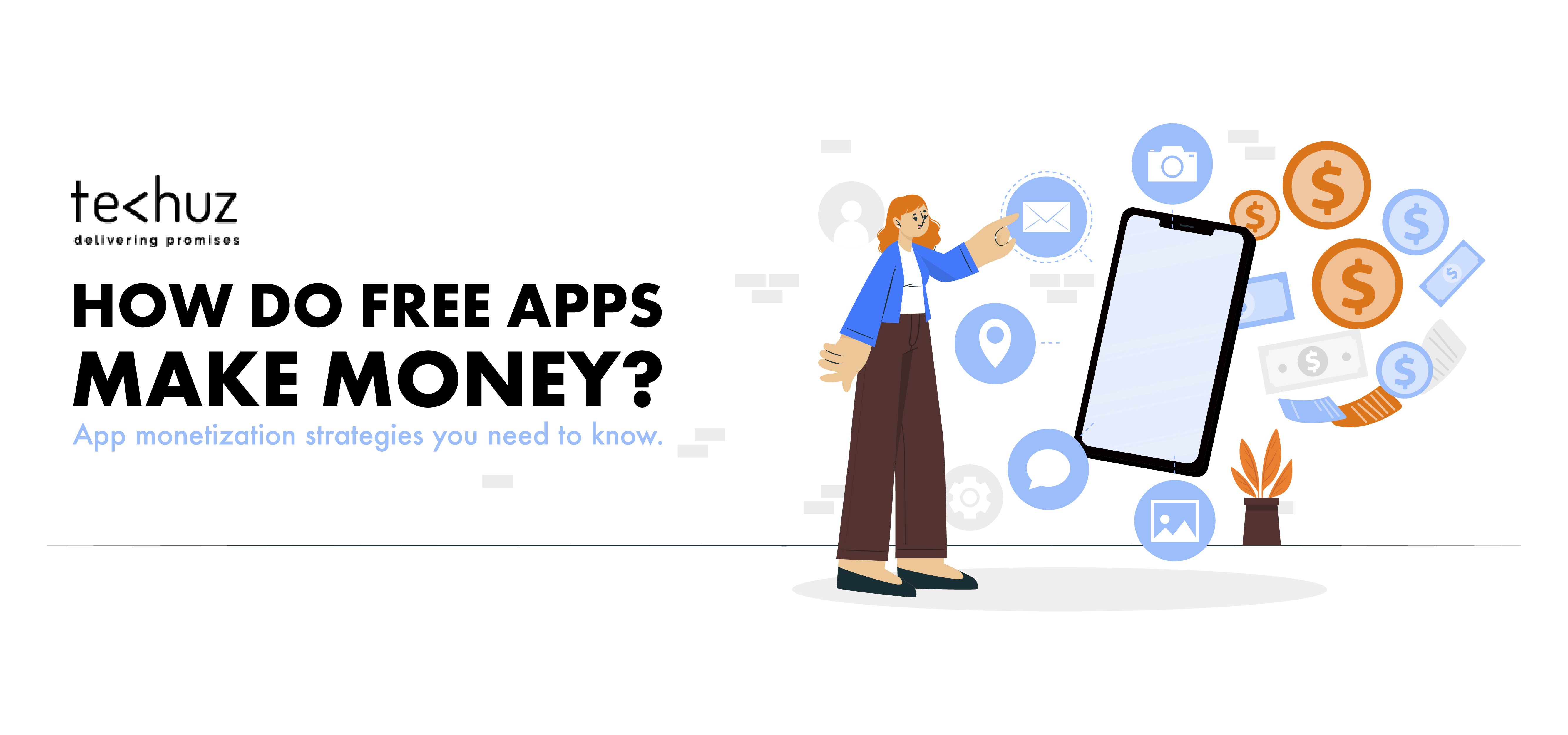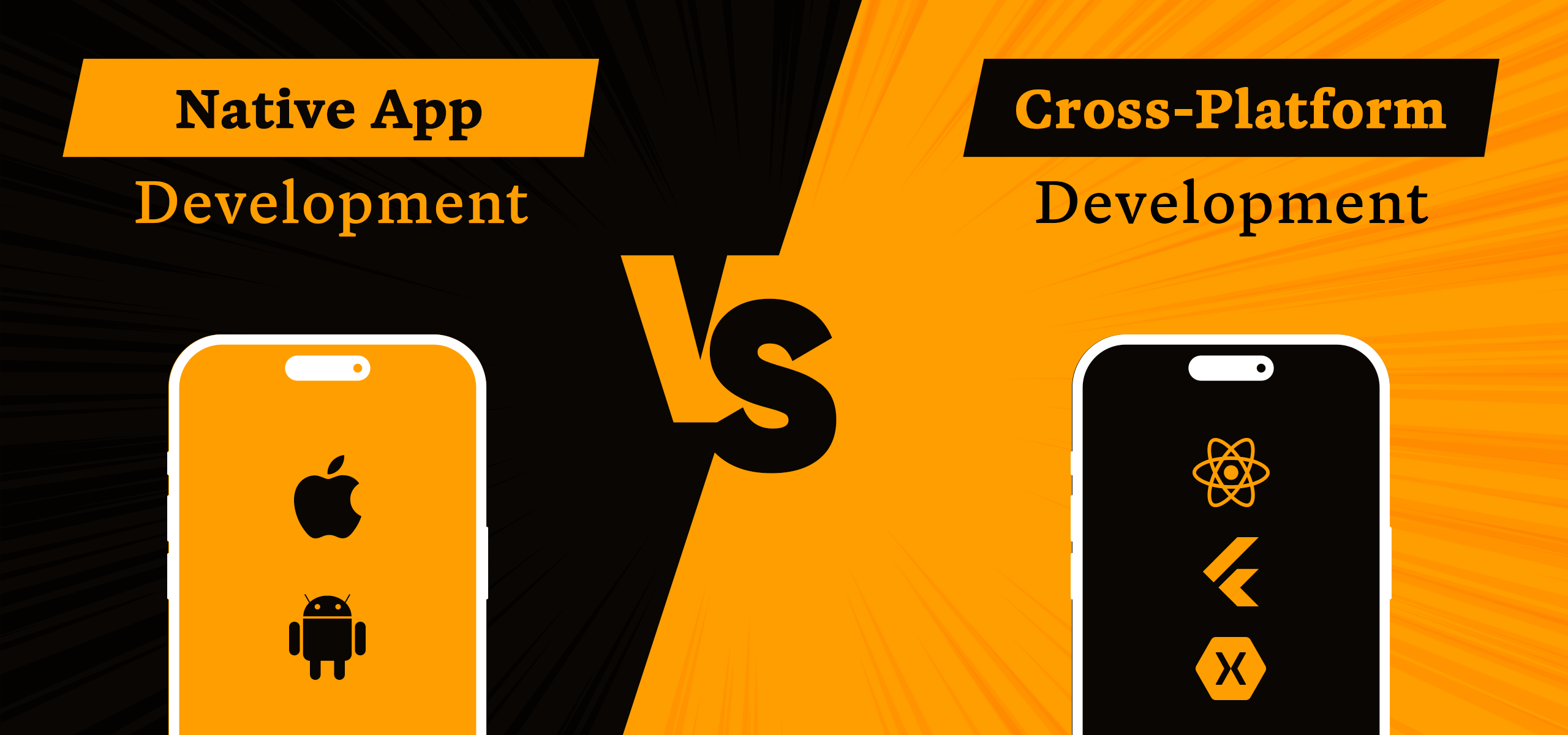Posted on
March 17, 2021
Updated on
March 20, 2024
Read time
 17 mins read
17 mins read
Quick summary: Free apps use various monetization strategies and business models such as in-app advertising, in-app purchases, subscription, sponsorships & partnerships, selling APIs, and merchandise sales.
FREE apps make big bucks.
No matter how counterintuitive that statement sounds, you can’t deny that FREE apps generate huge revenue. The ‘free’ label doesn’t stop them from raking in moolah.
A recent report by Sensortower shows mobile users spend $111 billion on mobile apps in 2020. Call it the effect of global lockdown, but that’s an all-time high making the app business a hundred-billion-dollar market. Any guesses which apps were the top grosser?
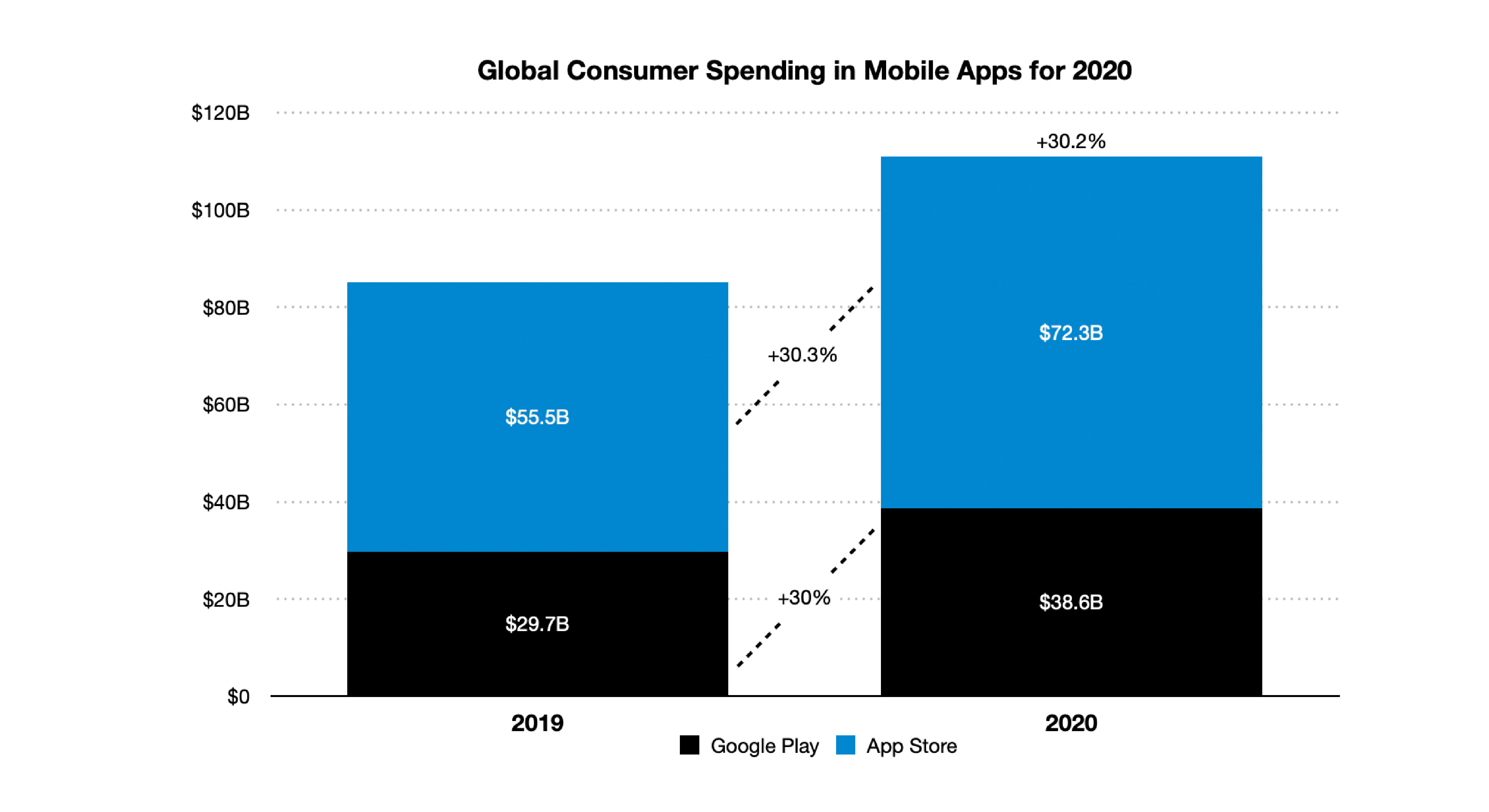
Of course, they were the free ones.
To name a few — TikTok, YouTube, Tinder, and Tencent Video were the non-game apps while PUBG Mobile, Arena of Valor, Pokemon, and Coin Master were the top mobile games.
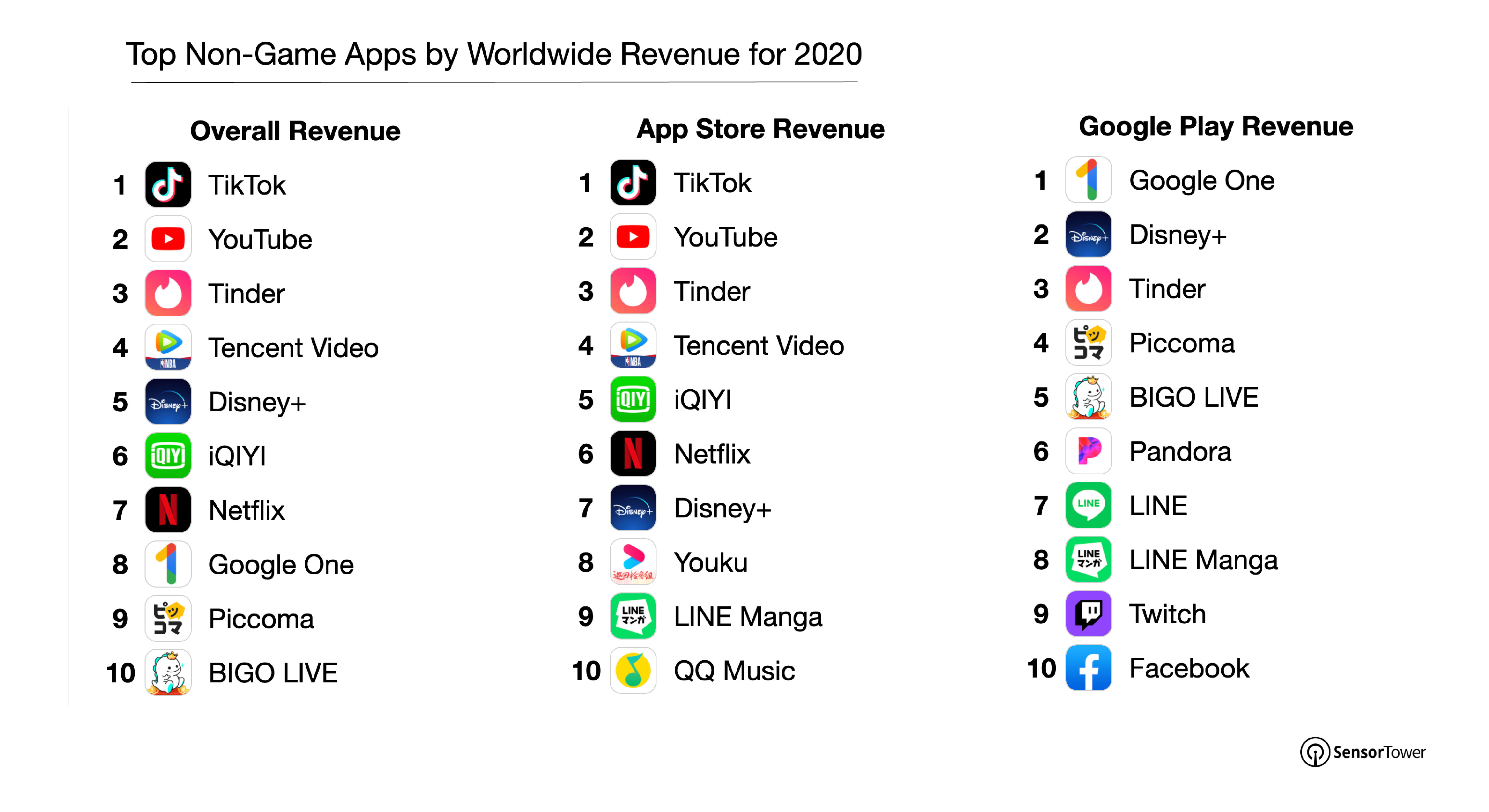
By now, you might have an epiphany. If not then let me tell you — all these apps are free to download but they use smart monetizing strategies to earn money. And that’s what we’re going to discuss today: How do free apps make money?
In this article, we’ll go through:
- The free app business model
- How do apps make money — popular app monetizing strategies
- Selecting the right monetization strategy for your app
- Creating an app that makes money
Understanding the Free App Business Model
Providing a commodity for free to earn a profit is not a new business model. We’ve witnessed it in the past. Give a free razor, sell disposable blades; give a free cell phone, sell the calling and data plan; install a free coffee machine, sell expensive coffee and refills.
But virtual products like mobile apps make the free business model more viable than the physical ones. Producing material products for millions of users and offering them for free can be quite expensive. But creating a digital product and providing it for free on large scale is relatively feasible. Entrepreneurs know this and this has been adopted for mobile apps. Give apps for free then upsell and monetize the offering. That’s the idea behind it.
Benefits of the Free App Model
One of the prime benefits of this model is that it reduces friction while user acquisition. A marketer may know that user acquisition is a herculean and expensive task. Asking users to cough up money while making them install the app might not be the ideal strategy. But offering it for free removes some barriers and hesitation.
Another powerful advantage of free apps comes due to their mass adoption. Free apps have a far larger user base than paid apps and this is an important metric that investors consider. Recognizing that a huge user base is a potential for monetization and better return on investment. This large user base of free apps can help in acquiring funds.
In a nutshell, the free app model is the strategy where one offers free to download apps and later upsells premium services or monetizing them using different strategies. Now let’s discuss these monetization strategies and models.
How Do Free Apps Make Money — Popular App Monetization Strategies
- In-App Advertisements
- Freemium
- In-App Purchase
- Subscription
- App Sponsorships and Partnerships
- Crowdfunding
- Sell APIs
- Consumer Products & Merchandise Sales
1. In-App Advertisements
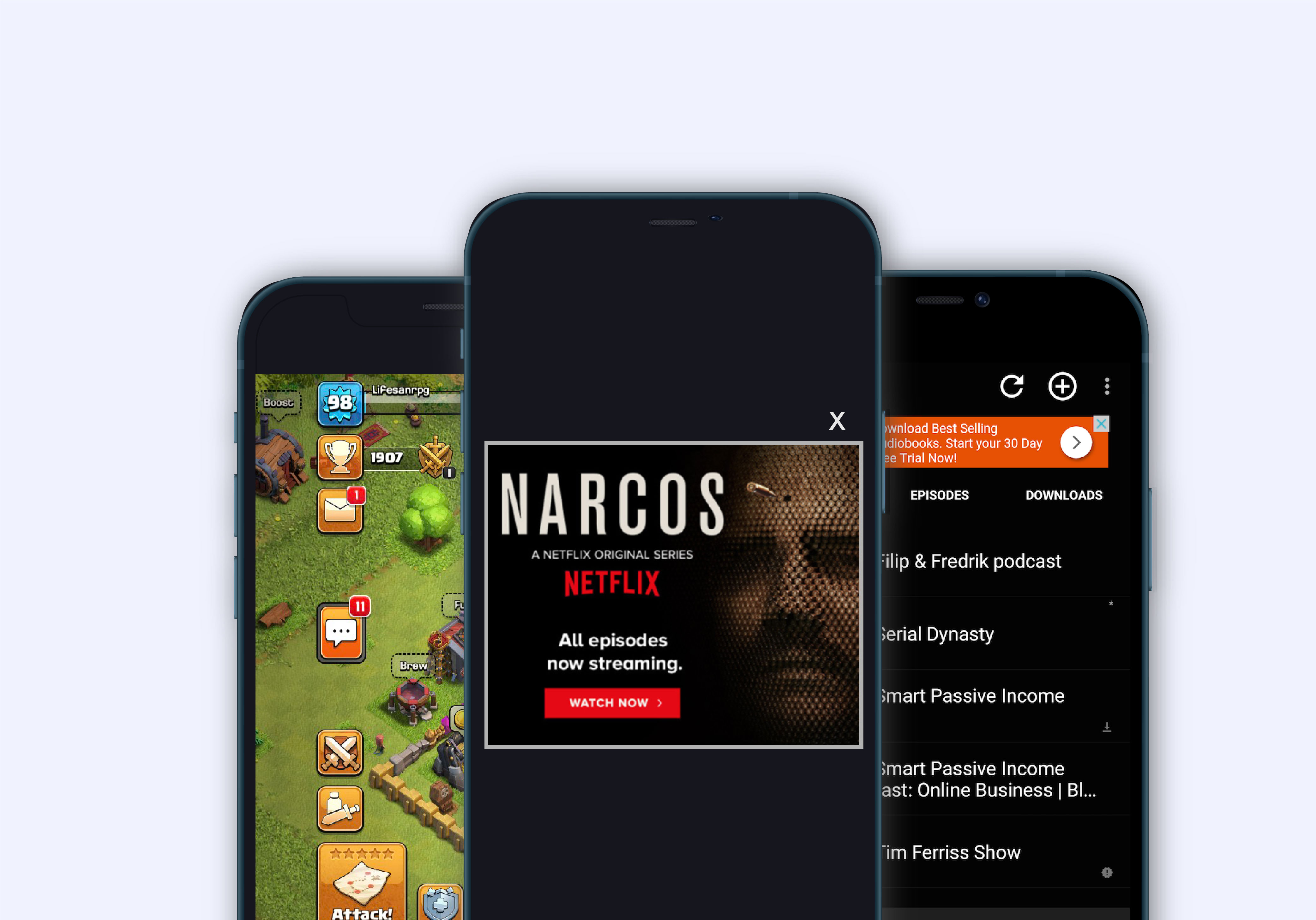
Ads are everywhere. Users are bombarded with commercials across all media channels. On average, people are exposed to 5000-10,000 ads each day in America. While the global spending on mobile advertising was reported over a colossal $224 billion in 2020. No wonder, why advertisements are a great way for apps to make money.
App owners are the ad publisher who monetizes the app by allowing advertisers to place ads. You display the ads in your app; you get paid for it. It’s that simple. But how do you do it?
Well, it’s done through a mobile ad network — a marketplace where you can sell the ad space to the advertisers. It connects you with the advertisers who can then place their ads in your app. Some of the top ad networks in the market are AdColony, Unity Ads, ironSource, Apple Search Ads, Admob, and Airpush.
Calculating Ads Payout
The payout is calculated based on the different models of ad campaigns. The most popular ones are cost per click (CPC), cost per view (CPV), and cost per install (CPI).
- CPC deals the clicks on displayed ads and payout is calculated on the cost per miles basics. Cost per miles refers to payouts for every thousand (miles in Latin) clicks on the ads.
- CPV is calculated on the 30 seconds of the video ad viewed by the user or interaction with the ad whichever comes first. In the case of shorter video ads, the full duration of the ad or interaction whichever comes first is considered.
- With the CPI, you get paid when the users take an action to the advertisement — like installing the advertised app.
Apart from these models, the payout is also calculated based on the different ad formats. Here are the 6 formats that you must consider.
- Banner Ads. These ads are usually placed at the top or bottom of the screen with text and graphic elements without obstructing the app’s usability. These ads are relatively simple and have less CPM payout. As per a report, the highest eCPM with banner ads was found to be $0.60.
- Interstitial Ads. These are the full-screen ads displayed at specific times or events such as after completing a task or between the game levels. However, since these full-screen ads are placed between the apps, they may interrupt the user. But they are also reported to reward high payouts with over $11 eCPM just like other full-screen ads.
- Native Ads. The concept of native ads is to blend in with the app’s experience. These ads are getting more and more popular due to it’s less interruptive nature and in fact, even perform better in terms of views and interaction. A great example of native ads is Instagram’s in-feed ads.
- Video Ads. Video ads are typically 10-30 second long videos placed in between different events and natural pauses. And just like interstitial ads, they have the same good payouts.
- Rewarded Video Ads. These are subsets of video ads that incentivize the user for finishing a video ad. Unity Ads describes it as the “hottest revenue generator” as it has the highest eCPM of over $17. These ads also aid in improving the retention rate and engagement with the apps.
- Playable ads. Now, this is a relatively new type of ad that allows users to interact with the ads.
While advertisements are an effective and primary revenue stream for free apps, it also comes with challenges. The main challenge is to maintain the right balance of app content and ads. You must ensure the ads are not too intrusive affecting the user experience and at the same time enabling you to earn enough revenue.
2. Freemium
The freemium model is focused on upselling the premium functionalities to the free users. In this model, users are offered the app with basic functionalities, while the full set of features, premium functionalities, and enhanced experience can be unlocked by upgrading to a paid version.
The key to making the freemium model work is providing great value to the users with the free app.
Right from the first session, your app must start building trust and creating value. When users recognize the great service, utility, and fulfilling experience, they eventually are convinced to spend money on premium features. You can’t expect an unhappy user to make a purchase. So regardless of free or paid users, your app should provide something great.
One fine example of the freemium model is Spotify. It provides flawless music streaming with an extensive archive of songs and a superb user experience —all these with its free version. However, users can get even better functionalities and experiences by upgrading to a premium subscription. That’s also a good example of the right balance of free and paid offerings. With this model, Spotify has managed to achieve a staggering conversion of 42%.
3. In-App Purchases (IAP)
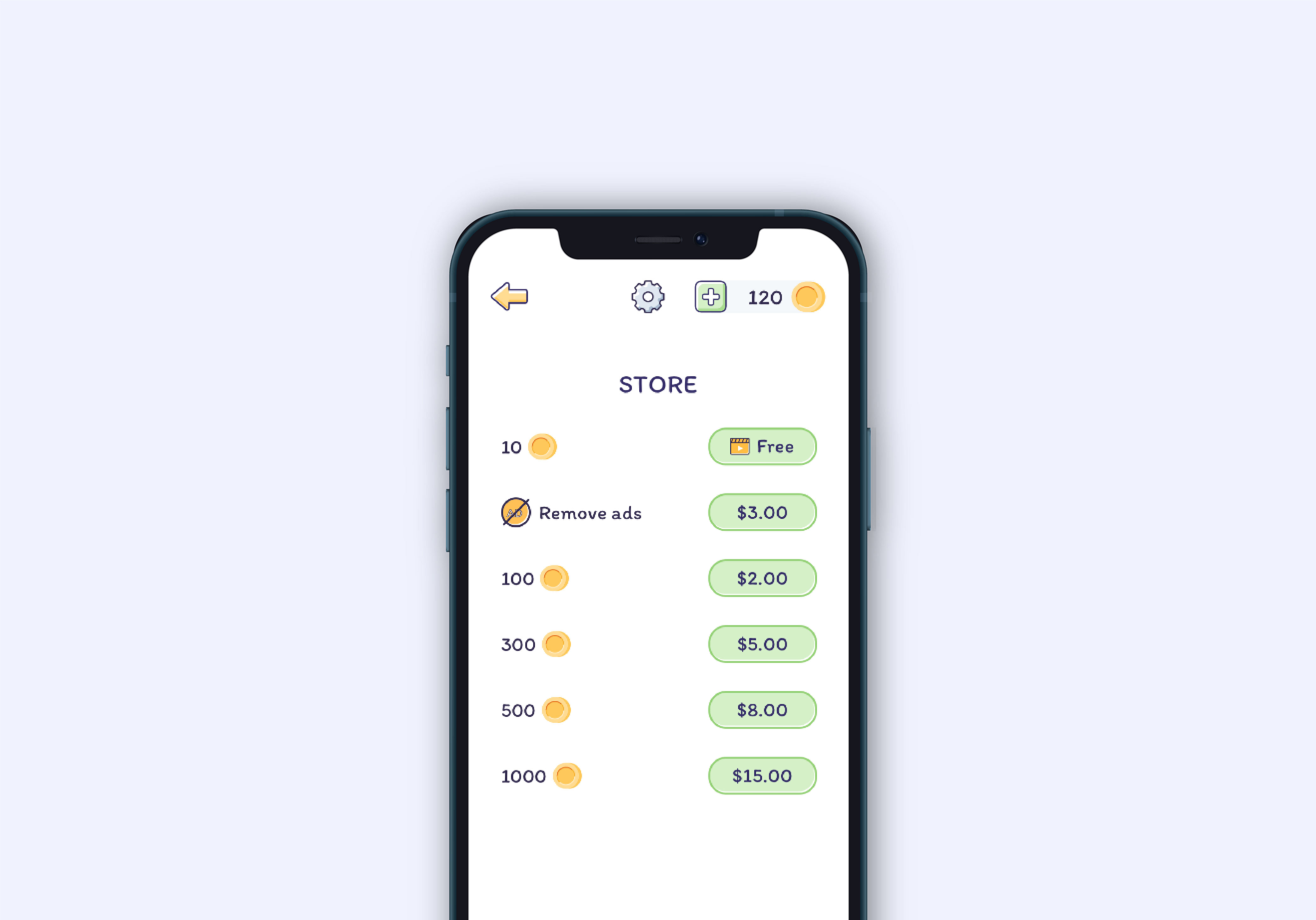
In-app purchases (IAP) are the additional features, functionalities, and virtual items that users can buy in the app. This typically gives users access to special content and items like virtual currencies or a feature. This is strategy is a subset of the freemium model and is used by free games like Candy Crush and PUBG Mobile, and apps like VSCO.
Three types of IAPs used to generate revenue — consumable, non-consumable, and subscriptions.
Consumable IAPs are one-time consumable items — virtual currencies, power-ups, extended gameplay, or an additional feature. These purchases are popular with mobile games.
Non-consumable IAPs are typically permanent features that users buy in the apps — such as the option to remove ads or a premium photo filter.
Subscriptions give users access to services or additional features at a recurring charge for a certain period of time. These can be either renewable or non-renewable and are popular with streaming and news apps.
In-app purchases are one of the primary drivers of revenue for free apps and year by year it’s on the rise. One of the reasons for this is reported to be the rapidly growing purchasing power of the two tech-savvy generations — Millennials and Gen Z.
But even in-app purchases come with their own challenges. Implementing an IAP requires extra work on the backend so that transactions run smoothly. Another thing is when your users pay you for something you must ensure they are getting the best experience; that’s not only in-app experience but even the app-like customer support. And most importantly, you’ll have to give away a huge chunk of the purchase — 30% as commission to Google Play and App Store.
4. Subscription
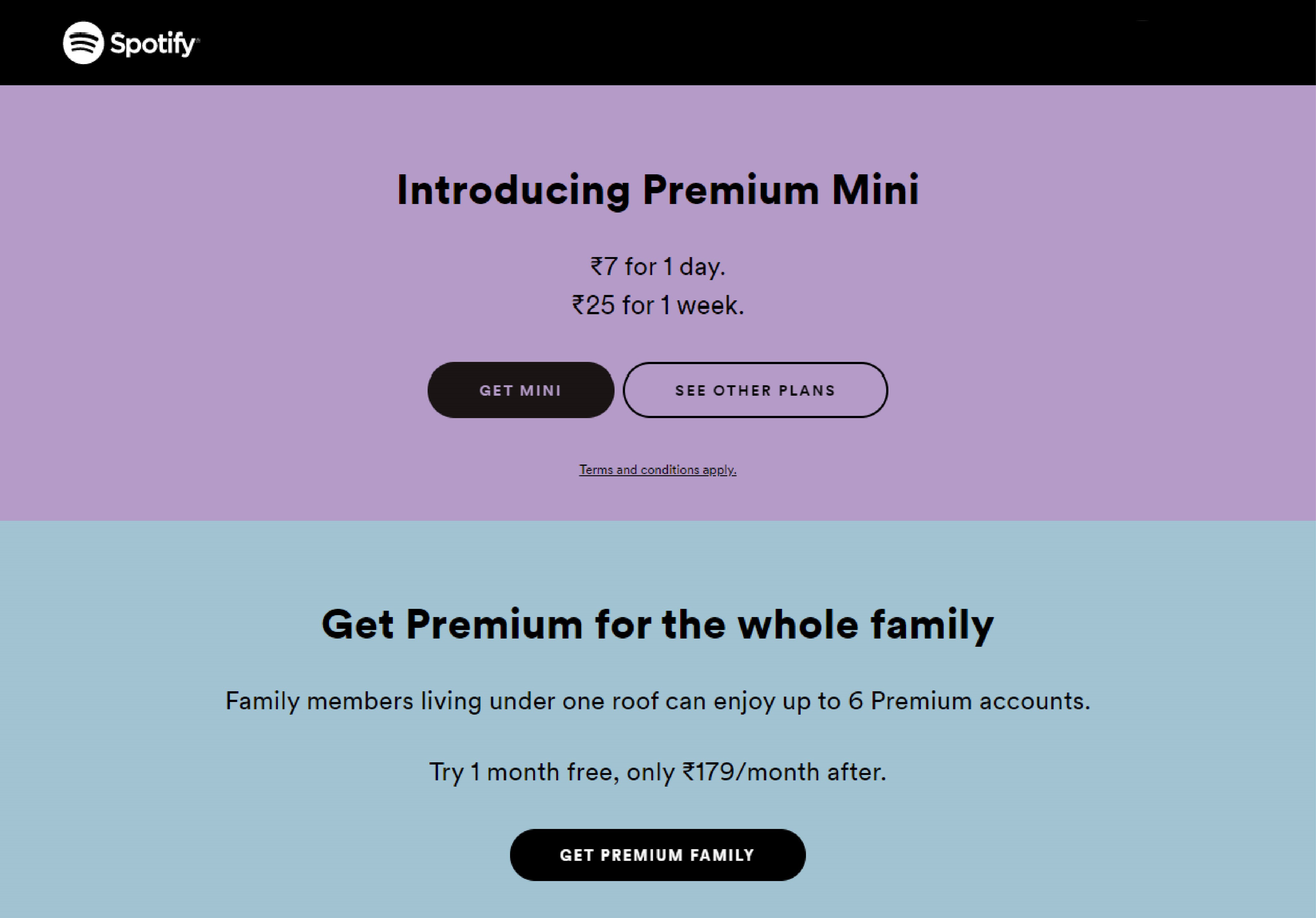
Subscription is the standard monetization strategy for many service-based apps. The way it works is simple. Your free app provides limited features or experience, and to unlock full access the user has to subscribe to a plan. This is another subset of the freemium model.
Subscription is highly used in streaming apps like Spotify and YouTube, news & media apps like New York Times, productivity apps like Headspace, and even some brain games providing frequent new content.
The subscription model yields a win-win situation for both businesses as well as users. From the business perspective, subscription-based apps tend to earn higher as well as stable revenue. Stats show subscription-based apps earn 2-3 times higher revenue compared to just ad revenue and even paid apps. Also, it faired nearly 50% more than in-app purchase revenue.
With a reliable and stable revenue stream, it becomes a lot easier to put your efforts into upgrading your app and spending a budget on marketing.
The subscription also allows you to target multiple user groups with several subscription plans setting the price and features as per their needs. At the same time, it is more convenient for the users to purchase the offerings.
Even Apple and Google favour the in-app subscription model by providing incentives for implementing it. While for the first year, the stores charge 30% commission, the commission decreases to 15% from the second year and all successive years till the user is subscribed.
This model is ideal for content-based apps like news and streaming apps where the user gets new content for a recurring subscription.
It is also suitable for service-based apps that provide value on recurring basics or that users would use for the long term.
However, the recurring revenue demands to provide recurring value. So make sure your users get it. Also, it needs excellent customer support.
5. App Sponsorships and Partnerships
Brands are always on the hunt for a strong presence and results, and in-app sponsorships have come up as an ideal mobile marketing strategy. While for free apps, it’s another great way to earn money.
In-app sponsorship and partnership take advertising to the next level. It provides advertisers with a more integrated presence by connecting to the right audience with the purchase intent. It also helps the advertisers associate their brand with the positive app experience improving their brand awareness and sales.
However, to attract such sponsors, your app must have a huge or niche userbase that exposes brands to the ideal audience and drive results. Weather Channel App displaying Home Depot sponsorship is a great example. Home Depot, a home improvement company, is targeting people to weatherproof their houses through the Weather Channel App.
Apart from generating revenue, partnerships with other products and apps can improve the user experience and app offerings.
In 2018, Headspace and Nike+ partnered together to provide athletes with a perfect mind and body training. Headspace’s guided meditation while running with Nike’s activity tracker helped users improve their training sessions. This also resulted in higher user engagement.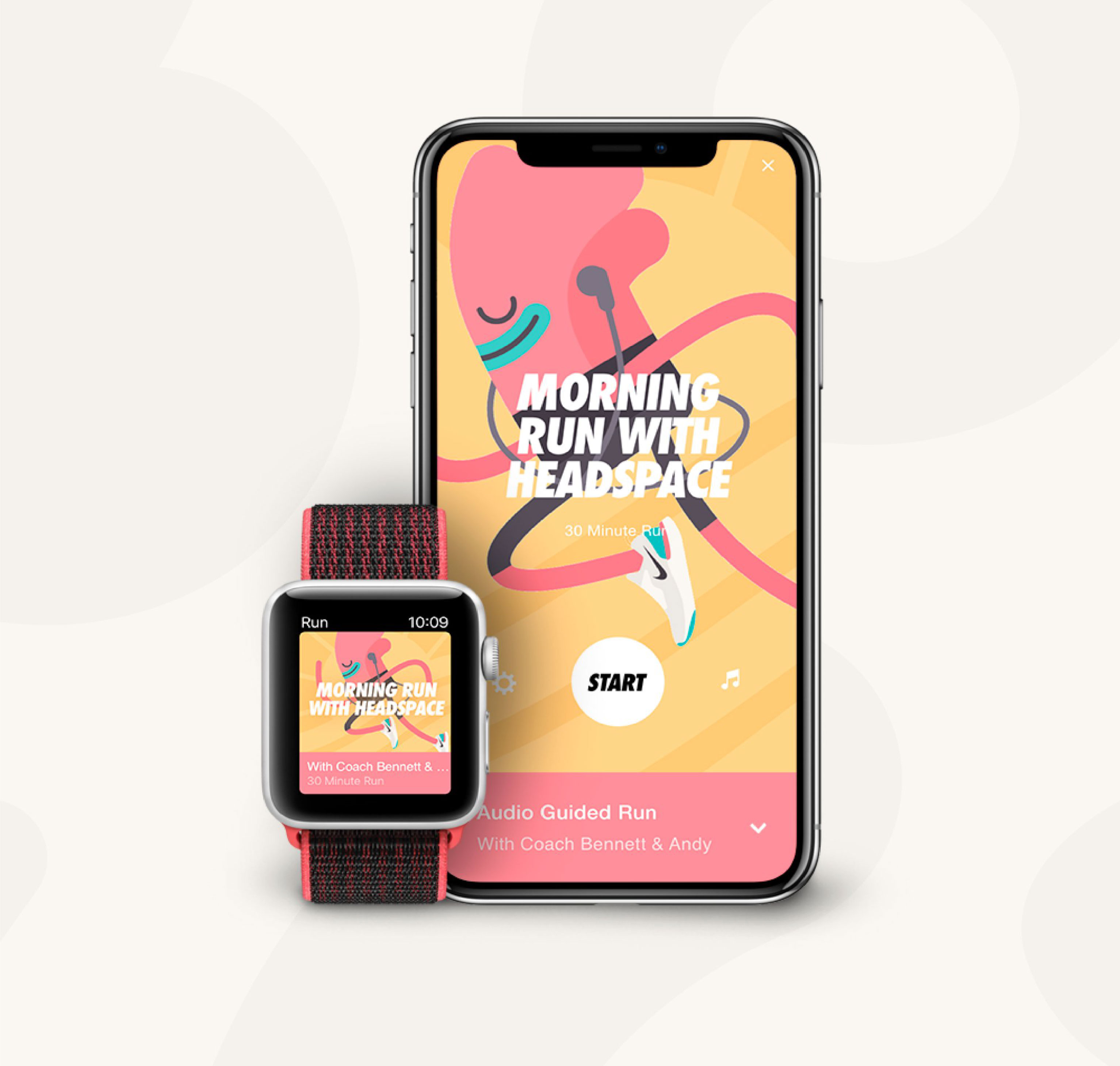
(Headspace partnered with Nike+ to incorporate mindfulness into workouts helping athletes make the most of their training. Image source – HeadSpace )
So in-app sponsorship and partnership are a great way not only to earn revenue but also to expand your offering and provide a unique user experience.
6. Crowdfunding
Crowdfunding is pretty mainstream these days. If you have a great idea, there’s a crowd to back you. Thanks to crowd-funding platforms like Kickstarter, Patreon, Crowd Supply, Fundable, Indiegogo, and Chuffed. (And, of course, thanks to individuals making small contributions on a large scale.)
Crowd-funding works differently than other ways of making money for apps. This strategy can help you get the funds you need for app development and marketing.
In past, however, non-tangible products like apps faired poorly in crowdfunding campaigns. Over the years, this has changed. Some mobile games have been able to reach the goal of $100,000, while even non-gaming apps ranging from education, social, dating, productivity, etc have seen even better responses. Fluent Forever, a language learning application has raised over $580,000 on Kickstarter.
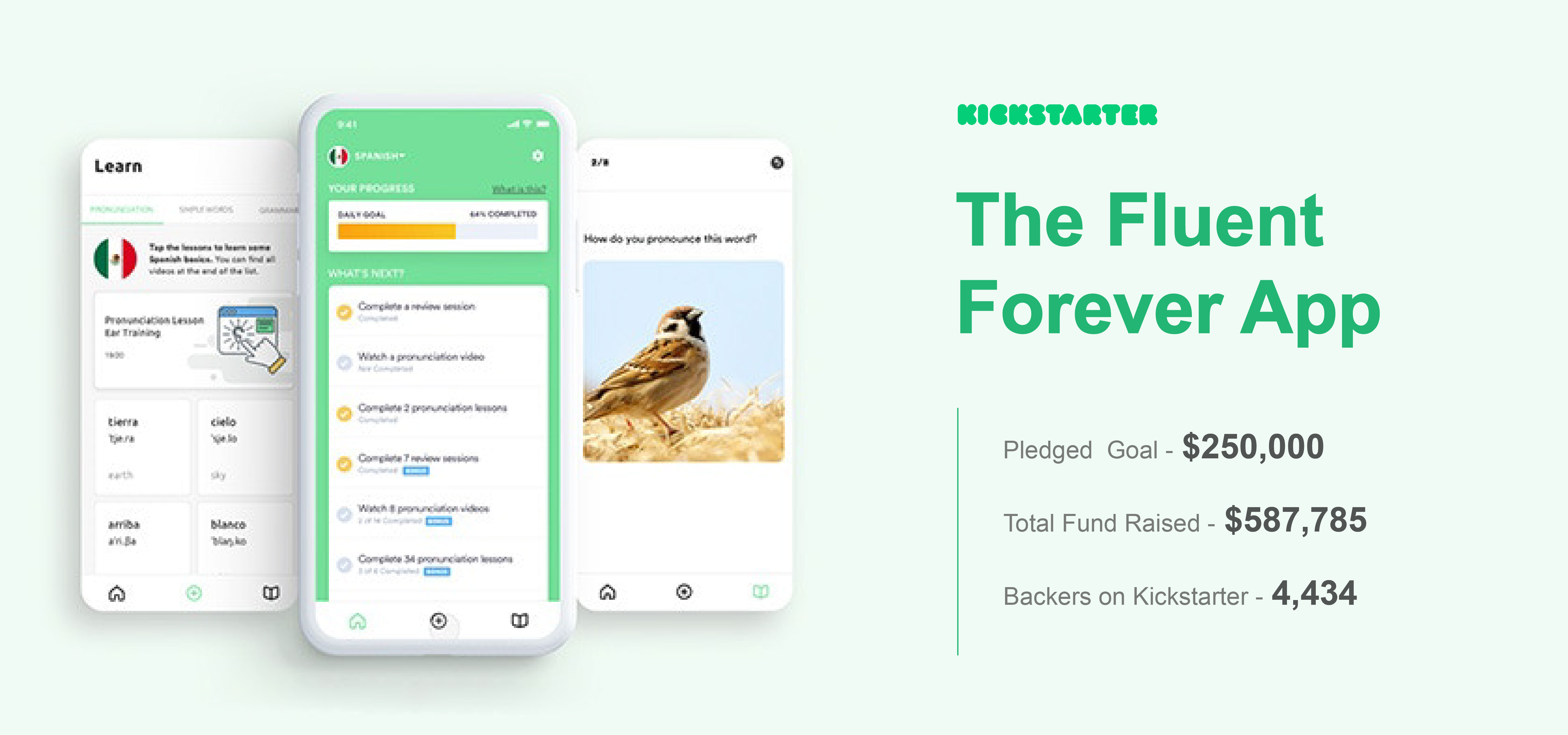
(Fluent Forever, a language learning app, has surpassed its goal of $250,000 and raised over $580,000 on Kickstarter.)
If you are looking for crowdfunding for your app, you need to reach and connect to a large crowd to back you. And for that, you must work on building your brand and a strong promotional campaign describing your app and your vision. However, funds through crowdfunding are just the beginning to compensate for the lack of initial capital. You must adapt to other viable monetizing strategies to earn money from your app.
7. Sell API
This is a whole different model for making money with your app. Instead of monetizing the app, this deals with selling the app API as a product.
Popular examples of apps providing APIs are Google Maps for navigation, Skyscanner for flights and hotels, MusiXmatch for lyrics and album database, and Vimeo for video.
Even WhatsApp, a free app with no ads or charges makes money by offering API to businesses. If you remember they used to sell the app for $1 in past, but Facebook later quit that model in 2016. Now it sells WhatsApp Business API to mid and large businesses as a customer communications solution. Uber, Booking.com, Singapore Airlines, and Wish are some of its famous customers. So, if your app has something unique to offer, you can sell the API to other apps and products.
8. Consumer Products & Merchandise
Physical purchases & merchandise are an alternate revenue model to earn money outside the app. Selling merchandise like toys, t-shirts, collectables, or other consumer products associated with the app can add a new stream of revenue.
Angry Birds is a great example of this monetization model. Rovio’s insanely popular casual game was reported to earn 45% of revenue from merchandise and other consumer products in 2012. In fact, from the plush bird toys alone it earned $1 million in revenue each month.
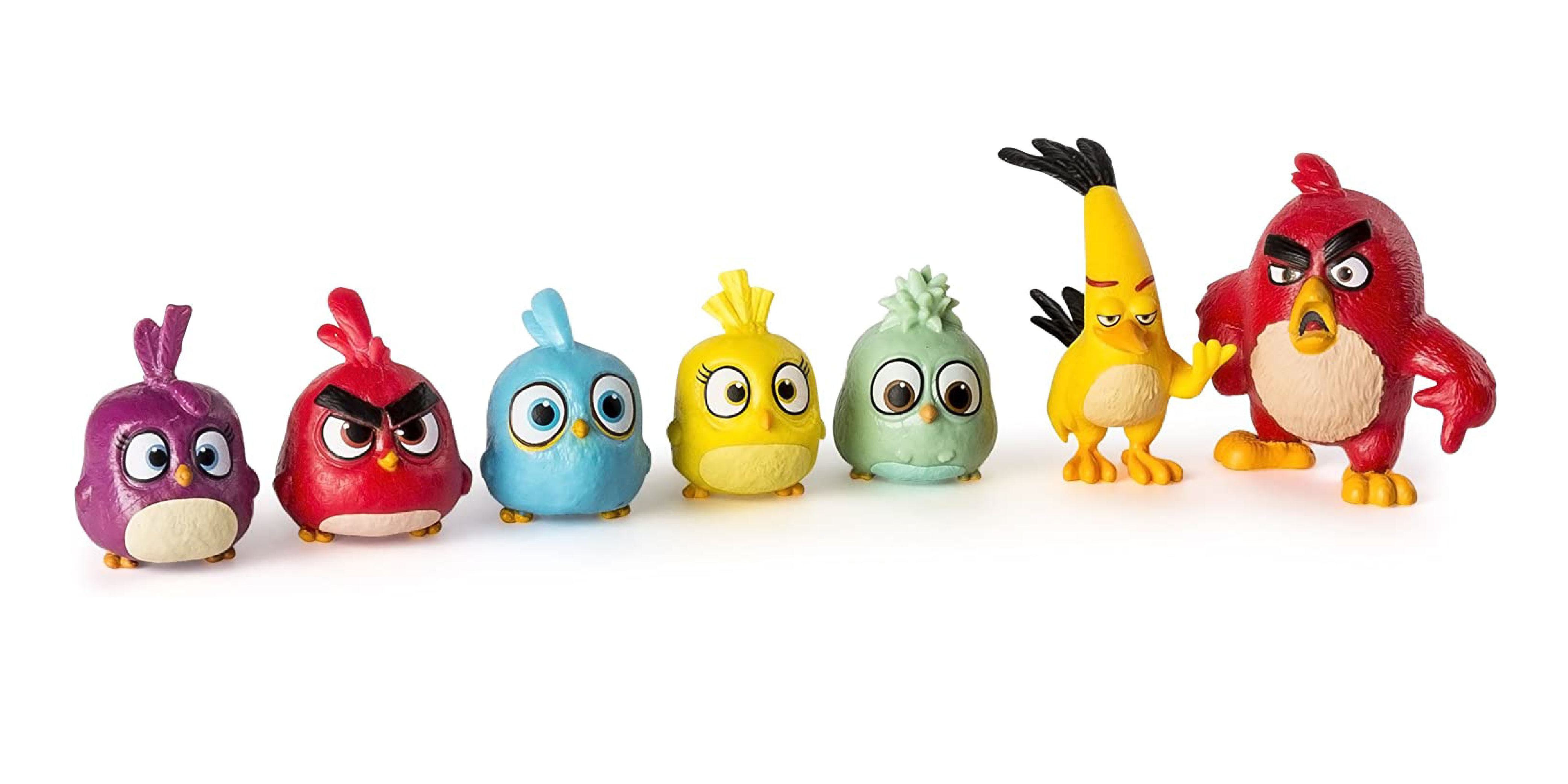
(Angry Birds games reported to generate £129 million in revenue in 2012 out of which 45% came from sales of consumer products and merchandise. Image source – Angry Birds: Heroes and Hatchlings Gift Set)
However, that huge amount of revenue was the result of its immense popularity and its success as a brand. So apps looking to earn merchandise must consider their brand connection with the users.
Another way to earn through selling merchandise is to sell products complementing or associating with your app. For instance, a fitness app can sell equipment for home workouts. However, this way of making money through apps has limits and is only ideal as an add-on revenue stream along with other monetization strategies.
Selecting The Right Monetization Model For Apps
There are several factors you must consider while selecting the ideal monetization model for the app — such as business goals, app category, offerings, audience, and even pricing.
You may want users to get the best experience — so minimizing ads and upselling premium may work for you. Or your app delivers frequent new content making it ideal for a subscription model. Or maybe your target audience prefers free rewards through ads rather than purchasing — which makes rewarded ads the right strategy for you.
Just keep in mind that app monetization models are quite flexible. You don’t have to stick to one and ignore the other. It’s best to mix the models as per your offerings and audience — creating a good balance of revenue generation and creating value.
Creating Mobile App That Makes Money
So that was all about how mobile apps make money. But before generating revenue from the app, you have to develop one. Let’s say you already have a great app idea. It solves users’ problems and creates value. That’s a good start. But, not enough to drive revenue from it.
Your idea must be properly executed to attract users and convince them to pay. You need to create a functional app. And to do that your app must have three things: great user experience, impeccable code, and accurate app packaging.
Well-Thought UX
Your app must create positive experiences for users. And it all starts with a well-thought user experience design. UX design ensures that the app is designed keeping the users’ needs first. This translates into a pleasant user experience and happy users.
Impeccable Code
The app must be flawless — impeccable code, properly executed functionality, perfect integrations, performance, and stability. It must be built using the app standard best practices outlined by each operating system. And before the app goes live it must go through rigorous testing and continually improve as per the user feedback.
Accurate App Packaging
As per a report, more than 50% of the users discover the apps within the mobile app stores. And 65% of the iOS app downloads come from App Store searches. This makes your app packaging — the way you present it in the store — a crucial factor for its success. You must work on —
- Catchy name for your app
- Write a clear and informative description
- Create attractive app screen-shots and demo videos
- Optimize for app stores (ASO)
Frequently Asked Questions
1. How do free apps make money?
Free apps can generate revenue through advertising, in-app purchases, freemium model, subscription model, or by offering premium features for a fee.
2. What is the most common way for free apps to make money?
Advertising is the most common way for free apps to make money.
3. How does advertising work in free apps?
Advertisers pay app developers to display their ads within the app, and the revenue is split between the app developer and the advertising network.
4. What is the freemium model?
The freemium model allows users to download the app for free but charges for premium features or additional content.
5. What is the subscription model?
The subscription model charges users a recurring fee, usually monthly or annually, for access to premium content or features.
6. How do in-app purchases work?
In-app purchases allow users to buy virtual items or additional features within the app.
7. Can users still enjoy the app without making in-app purchases?
Yes, users can still use and enjoy the app without making in-app purchases, but certain features or content may be restricted.
